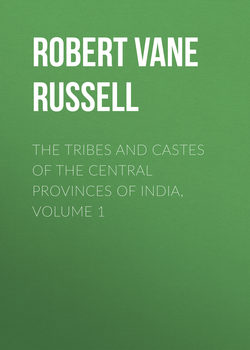Читать книгу The Tribes and Castes of the Central Provinces of India, Volume 1 - Robert Vane Russell - Страница 42
Part I.
Introductory Essay on Caste
Introductory Essay on Caste
39. Of the Dravidian tribes
ОглавлениеThe Dravidian languages, Gondi, Kurukh and Khond, are of one family with Tamil, Telugu, Malayalam and Canarese, and their home is the south of India. The word Dravida comes from an older form Damila or Dramila, and was used in ancient Pali and Jain literature as a name for the people of the Tamil country.75 Afterwards it came to signify generally the people of southern India as opposed to Gaur or northern India.
As stated by Sir Edward Gait there is at present no evidence to show that the Dravidians came to southern India from any other part of the world, and for anything that is known to the contrary the languages may have originated there. The existence of the small Brahui tribe in Baluchistān who speak a Dravidian language but have no physical resemblance to other Dravidian races cannot be satisfactorily explained, but, as he points out, this is no reason for holding that the whole body of speakers of Dravidian languages entered India from the north-west, and, with the exception of this small group of Brahuis, penetrated to the south and settled there without leaving any traces of their passage.
The Dravidian languages occupy a large area in Madras, Mysore and Hyderābād, and they extend north into the Central Provinces and Chota Nāgpur where they die out, practically not being found west and north of this tract. As the languages are more highly developed and the culture of their speakers is far more advanced in the south, it is justifiable to suppose, pending evidence to the contrary, that the south is their home and that they have spread thence as far north as the Central Provinces. The Gonds and Oraons, too, have stories to the effect that they came from the south. The belief has hitherto been, at least in the Central Provinces, that both the Gonds and Baigas have been settled in this territory for an indefinite period, that is, from prior to any Aryan or Hindu immigration. Mr. H.A. Crump, C.S., has however pointed out that if this was the case the Munda or Kolarian tribes, which have lost their own languages, should have adopted Dravidian and not Hindu forms of speech. As already seen, numerous Kolarian tribes, as the Binjhwār, Bhaina, Bhuiya, Baiga, Bhumij, Chero, Khairwār and the Kols themselves in the Central Provinces have entirely lost their own languages, as well as the Bhīls and Kolis, if these are held to be Kolarian tribes. None of them have adopted a Dravidian language, but all speak corrupt forms of the ancient Aryan vernaculars derived from Sanskrit. The fact seems to indicate that at the time when they abandoned their own languages these tribes were in contact with Hindus, and were not surrounded by Gonds, as several of them are at present. The history of the Central Provinces affords considerable support to the view that the Gond immigration occurred at a comparatively late period, perhaps in the ninth or tenth century, or even later, after a considerable part of the Province had been governed for some centuries by Rājpūt dynasties.76 The Gonds and Oraons still have well-defined legends about their immigration, which would scarcely be the case if it had occurred twenty centuries or more ago.
Any further evidence or argument as to the date of the Dravidian immigration would be of considerable interest.
75
Linguistic Survey, p. 277.
76
See for this the article on Kol, from which the above passage is abridged.
